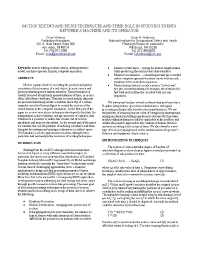Mining Publication: Motion Editing and Reuse Techniques and Their Role in Studying Events Between a Machine and its Operator
Original creation date: April 2002
Motion capture involves recording the position and global orientation of joint sensors of a real object, in most cases a real person performing some human activities. This information is usually recorded at uniformly spaced instances of time, or as it is often called frame-by-frame. Then the recorded motion data sets are processed and mapped into a skeleton hierarchy of a virtual, computer simulated human figure to control the motion of the virtual human in the computer simulation. In the first part of the paper we review several new techniques developed to facilitate the manipulation, noise reduction, storage and reuse of captured data, which have a potential to reduce the overall cost of motion simulation and improve its realism. In the second part of the paper we consider the real life problem of reducing a worker's risk from being hit by underground mining machinery in a confined space. We formulate a set of requirements to motion editing for this particular task and analyze the limitation of existing techniques.
Authors: O Volberg, DH Ambrose
Conference Paper - April 2002
NIOSHTIC2 Number: 20023447
In: Proceedings of the 2002 Society of Computer Simulation International, Advance Simulation Technologies Conference, 34(4), San Diego, California 2002 Apr; :181-186
See Also
- Analyzing Factors Influencing Struck-by Accidents of a Moving Mining Machine by Using Motion Capture and DHM Simulations
- Analyzing Factors Influencing Struck-By Accidents of a Moving Mining Machine by Using Motion Capture and DHM Simulations
- Developing Random Virtual Human Motions and Risky Work Behaviors for Studying Anthropotechnical Systems
- Machine Injury Prediction by Simulation Using Human Models
- Mine Roof Bolting Machine Safety: Investigation of Roof Bolter Boom Swing Velocity
- Mining Roof Bolting Machine Safety: A Study of the Drill Boom Vertical Velocity
- Modernization and Further Development of the NIOSH Mine Emergency Response Training System (MERITS), Phase 1
- A PC-Based Monitoring System for Mine Hoisting
- A Simulation Approach Analyzing Random Motion Events Between a Machine and its Operator
- Verification and Validation of Roof Bolter Simulation Models for Studying Events Between a Machine and its Operator
- Page last reviewed: 9/21/2012
- Page last updated: 9/21/2012
- Content source: National Institute for Occupational Safety and Health, Mining Program


 ShareCompartir
ShareCompartir
